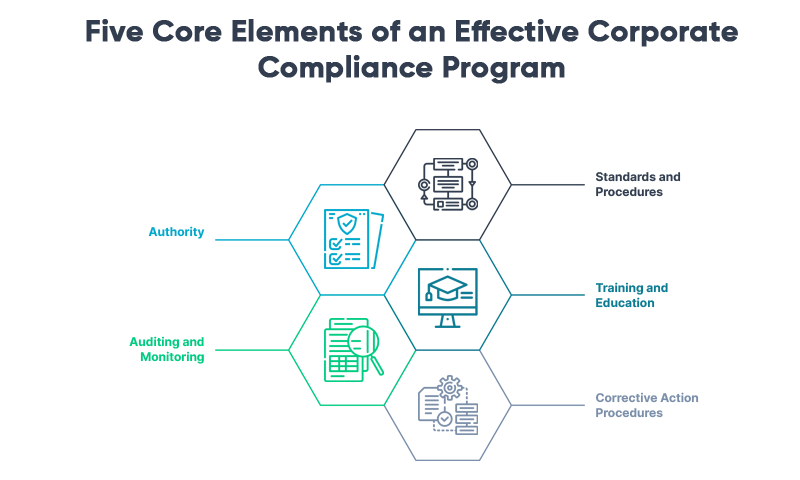The threat of the coronavirus has called for an enforced and stricter corporate compliance program. Improving regulation standards and renewing enforcement efforts is, therefore, more important than ever.
In this blog post, we’ll therefore address the most common questions related to corporate compliance and everything you need to know about building the best compliance program for your organization.
What is compliance?
In our recent post about business compliance, we defined compliance as both an action and a standard. Compliance as an action implies the necessity to comply with established regulations and policies. It also speaks about the duties and responsibilities of a company to its employees and society. Understanding its obligations, a company must take the necessary actions and measures to fulfill legal and or governmental requirements to stay compliant as an organization.
On the other hand, compliance becomes a standard when a company goes above and beyond and doesn’t treat compliance as a mere requirement but rather a code of conduct or an ethical compass for employees.
So, all in all, corporate compliance is both an action that reduces legal and safety risks. But it’s also a standard that leads people to appropriate behavior.
To gain a deeper understanding of the meaning of business compliance, one must view it both as an action and standard. If it is seen as an action alone, it can be reduced to a set of rules. Likewise, it might only serve as a branding decoration if it’s merely regarded as a standard.
Do all companies need a corporate compliance program?
All companies need a corporate compliance program. Regardless of its size, reach, or industry, a business must have a defined or structured compliance program that specifies its policies, procedures, and actions.
According to a 2017 study, it pays to invest in compliance seeing the cost of having more compliance activities (e.g., audits, training, and expert staffing) is lower than the cost of companies failing to comply with industry standards.
The same study also stated that the cost of non-compliance is 2.71 times the cost of compliance. Here are just a few impacts of non-compliance:
- Business disruption
- Productivity losses
- Revenue losses
- Fines, penalties, and settlement fees
Thus, taking preventive measures to follow compliance requirements can keep you out of trouble and help you save a significant amount of organizational costs.
What items should corporate compliance programs include?
Many corporations are unsure about what a corporate compliance training program should cover. And well, it all depends on the rules you want to enact and the issues you wish to address. But generally, corporate compliance focuses on these primary concerns:
Corruption
Building a strong culture of compliance begins with a commitment to doing business in an honest, ethical, and legal manner. But different forms of corruption like bribery, bid-rigging, and other unlawful business practices sometimes ruin the moral fiber of some employees. Therefore, creating compliance policies that focus on developing high standards of integrity minimizes the occurrence of this issue.
Employee behavior
Employee behavior has a direct correlation with workplace productivity, engagement, and efficiency. And any action that is seen as unprofessional or unethical disrupts the proper flow of corporate processes. To avoid these problems, compliance programs such as anti-harassment and anti-discrimination policies should be included.
Workplace health and safety
Employers have the legal duty and moral responsibility to ensure the safety and protection of their employees while at work. Therefore, companies must have a set of policies, plans, and procedures that help manage workplace health and safety. Its purpose is to minimize the risk of injury or illness among employees and is therefore equally as important to include.
The Occupational Safety and Health Administration or OSHA is one of the leading regulatory agencies in the world that provide standard guidelines on workplace health and safety management.
Environmental compliance
Some businesses consider environmental compliance as optional. But since ecological problems such as climate change and pollution impact businesses negatively, being environmentally compliant should be a serious consideration for every compliance program.
Data management
Anyone that comes into contact with your company brings tons of personally identifiable information. And it’s your company’s obligation to safeguard any sensitive information that can lead to data privacy issues. To be compliant in this area means outlining policies and processes that ensure data protection. This process may include implementing an Information Security Management System or ISMS.
Product compliance
It’s imperative that business products meet essential legal requirements. Thus, compliance should provide evidence that a product meets these regulatory requirements. Remember, taking responsibility for your products and services is a smart business.
Five core elements of an effective corporate compliance program
Now you know the basic elements of a corporate compliance program. But one thing is to decide on the content. Another thing is how you build your program and make sure it’s effective from the get-go.
The more complex compliance management is, the more difficult it is to convey. Thus, a successful compliance program is something that is focused, well-defined, and simple. To achieve this, make sure you have these five core elements:

Standards and procedures
Your compliance program should have a clear set of policies and procedures to define the framework of which your company operates. The laws or guidelines must be concrete, practical, and most importantly, accessible. When we say accessible, we mean that your corporate compliance policies should be conveyed regularly – especially when changes are made.
Authority
The initiative or support for a complete and comprehensive compliance program must come from the top management. If managers or supervisors fail to authorize compliance planning and implementation, the program will appear like a useless and toothless set of rules.
Furthermore, the company must have an official Chief Compliance Officer, who can serve as an overseer of all compliance activities.
Training and education
To formally educate your employees on industry-related or government-specific laws and policies, you should have a dedicated compliance training program to simplify the process.
Just like any other employee development activity within your learning academy, the objectives of compliance training must be SMART. Having SMART compliance goals and objectives can streamline your learning activities. It also helps you identify the right tools and best approach to succeed in your training initiatives.
With SMART objectives, you’ll find ways to make the learning process more engaging and suitable for employees. Possessing the right mindset and insight, you get to explore different strategies like using a Learning Management System for e-learning or online compliance training.
Auditing and monitoring
One way for organizations to never lose oversight of their compliance program is through constant monitoring and auditing. A good compliance monitoring and auditing system give companies a consistent set of protocols and facilitate the process of checking and detecting issues on a regular basis.
Whenever discrepancies are found in compliance, monitoring and auditing make it easier to conduct immediate analysis and a fitting response to prevent failures.
Monitoring compliance policies include recording current regulation changes, developing internal control procedures to comply with these changes, and informing the whole organization about significant updates.
On the other hand, auditing compliance entails reviewing and verifying the effectiveness of the ongoing monitoring processes. An action related to compliance audits involves validating whether the existing monitoring system achieves its desired outcomes.
In any case, the Chief Compliance Officer should make sure that both the auditing and monitoring departments are working hand in hand to mitigate possible compliance risks.
Corrective action procedures
Compliance is both a proactive and reactive response. Thus, your compliance management system must not only include concrete guidelines but also clear corrective actions. This means that whenever an issue of non-compliance or impropriety is encountered, you know how to respond with appropriate counteractive measures.
But just remember that corrective actions don’t exist in a vacuum. No counteractive response should be divorced from relevant areas of compliance laws or regulations. In other words, the actions that ought to solve non-compliance issues should be linked to appropriate sources such as:
- Audit results
- Actual incidents or human error
- Customer complaints
- Non-conforming agents
Normally, a corrective procedure follows these six phases: identification, evaluation, root cause analysis, corrective response, and follow-up.
Digitize your corporate compliance program
Digital transformation is almost inescapable when it comes to corporate processes – even in compliance. Unfortunately, companies see digital transformation as an opportunity to only strengthen customer relationships, streamline operations, and upscale their business. As a result, corporate compliance becomes an afterthought.
However, digital technology is prompting organizations to reimagine their corporate compliance systems. And the first step towards modernizing business compliance programs is to identify the barriers that hinder digital transformation.
And we want to help you break those barriers! Learn more about our services and let us help you start your digital transformation journey. Click this link to know how you can digitize your compliance program. Or contact us to get an idea of how you can build your own compliance training solution.


